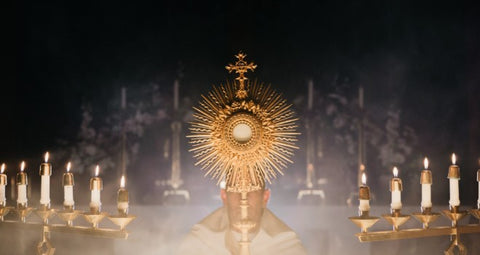At the heart of our Catholic faith lies the belief in transubstantiation, where the bread and wine offered during Holy Mass are transformed into the Body and Blood of Christ. While this belief is founded on faith and the very words of Jesus in the Gospel, certain remarkable events throughout history have served to affirm this divine mystery. One such event is the Miracle of Lanciano—an 8th-century miracle that continues to resonate with believers today, serving as profound proof of the real presence of Jesus in the Eucharist.
The Unfolding of the Miracle
The story of the Miracle of Lanciano takes us back to Italy in the 700s AD, in a small church in the city of Lanciano. During a Mass, a Basilian monk, who had doubts about the real presence of Christ in the Eucharist, was leading the congregation. As he uttered the words of consecration—"This is my body. This is my blood."—an extraordinary transformation occurred.
In front of the monk and the gathered faithful, the bread and wine on the altar visibly turned into flesh and blood. The monk was left in awe, his doubts washed away by the miraculous sight before him. Word of the miracle quickly spread, and Lanciano became a place of pilgrimage, attracting believers seeking to witness this affirmation of their faith.
Scientific Investigations and Findings
Over the centuries, the Church conducted several investigations to verify the Miracle of Lanciano. The most extensive examination took place in 1970 when a team of scientists, supervised by the World Health Organization, was given permission to study the relics—samples of the flesh and the dried blood.
The scientists concluded that the flesh was indeed human cardiac tissue. The blood was found to be human blood, type AB, the same blood type found on the Shroud of Turin and other Eucharistic miracles. Even more remarkably, the flesh and blood had not been preserved with any substances, suggesting a supernatural cause behind their centuries-long preservation.
The Eucharistic Connection
The Miracle of Lanciano holds a special place in the hearts of believers because of its direct connection to the Eucharist. Catholics believe in the real presence—that is, that Jesus is truly present in the bread and wine consecrated during Mass. The miracle at Lanciano provides tangible, scientific proof of this transformation, known as transubstantiation.
By physically manifesting the transformation of bread and wine into flesh and blood, the Miracle of Lanciano brings the faithful face-to-face with the divine mystery that lies at the heart of every Mass. It's a powerful reminder that when they partake in the Eucharist, they are partaking in a miracle.
Conclusion
The Miracle of Lanciano serves as an extraordinary testament to the core of Catholic faith—the belief in the real presence of Jesus in the Eucharist. To this day, the preserved flesh and blood can be seen in the Church of San Francesco in Lanciano, continuing to draw believers from around the world.
This miraculous event provides not just spiritual affirmation, but physical, observable proof of the real presence. It stands as a beacon for all Catholics, reinforcing the divine truth they embrace during every Eucharistic celebration—the bread is His Body, the wine is His Blood, and in them, we find Jesus, truly and wholly present.

